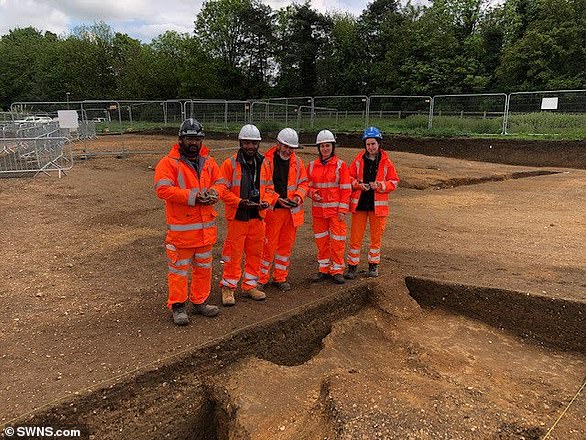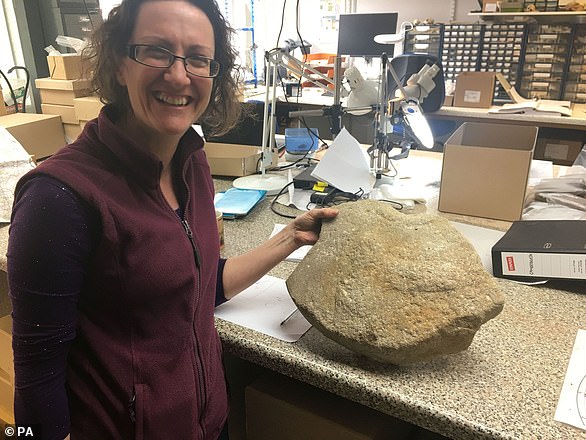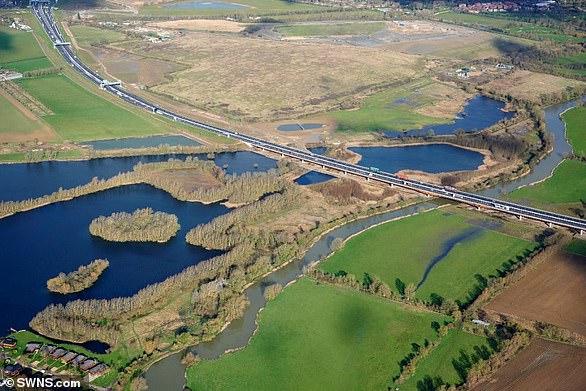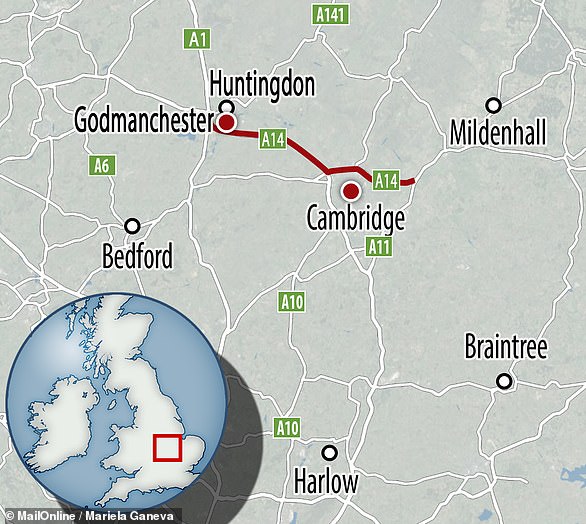Unusual statue featuring a frontal depiction of a man holding his phallus with both hands is discovered near to Mesolithic temple in Turkey
>
A Roman millstone found near Cambridge was decorated with a carving of a penis – an ‘image of strength and masculinity’ – archaeologists have revealed.
The millstone and others were uncovered three years ago during roadworks to improve a 21-mile stretch of the A14 between Cambridge and Huntingdon.
The finds came from the remains of a Roman villa near the town of Godmanchester, a spokesperson for Highways England told MailOnline.
However, the phallographic sculpture – which was created to bring luck and protection to the millstone and flour – was only recently identified by experts.
The improved stretch of road was opened to traffic in May last year, but the millstone was not the only archaeological find revealed before work was completed.
Other finds included the tusk of a woolly mammoth, the skull of a woolly rhino, an abandoned medieval village and three dismembered men from 1,500 years ago.
Archaeologists also found the earliest known evidence of beer brewing in Britain, dating back to as early as 400 BC.
A Roman millstone (pictured) found near Cambridge was decorated with a carving of a penis – an ‘image of strength and masculinity’ – archaeologists have revealed
According to Highways England archeology lead for the A14, Steve Sherlock, the penis-decorated millstone is important because it ‘contributes to the evidence base for such depictions from Roman Britain.’
‘There were well-known associations between images of the phallus and grinding, such as those found above the bakeries of Pompeii, one with the inscription Hic Habitat Felicitas – “You will find happiness here,” he explained.
‘The phallus was seen as an important image of strength and masculinity in the Roman world, with it being common for legionaries to wear a phallic amulet, which was said to bring them good luck before battle.’

The millstone and others were uncovered three years ago during roadworks to improve a 21-mile stretch of the A14 between Cambridge and Huntingdon. The photo shows the excavation site
The millstone was examined by experts from the Museum of London Archeology Headland Infrastructure and Oxford Archaeology.
In addition to carving the phallus on the top of the millstone, the team discovered two crosses engraved on its perimeter.
The quern itself would have been a simple hand mill, as it usually consists of two round stones between which corn is ground.
According to the archaeologists, the millstone appeared to have broken during use and was then adapted to be used as saddle quern – a base stone in the milling process – which would have hidden the genital statue from view.

The millstone was examined by experts from the Museum of London Archeology Headland Infrastructure and Oxford Archaeology. In addition to carving the phallus on the top of the millstone, the team discovered two crosses engraved on its perimeter. In the photo, Oxford archeology expert Ruth Shaffrey poses with the phallus-bearing millstone
The researchers reported that more than 300 querns millstones were recovered during archaeological work on the A14 upgrade project.
Decorated querns and millstones of any date are rare – and only four Roman millstones have ever been discovered, out of a total of around 20,000 in the whole country.
Although crosses on such stones are more common, they are usually only found at military sites, the team explained.
‘As one of only four known examples of Romano-British millstones decorated in this way, the A14 millstone is a very important find,’ says Ruth Shaffrey, worked stone specialist at Oxford Archaeology.
‘It provides an insight into the importance of the mill to the local community and the protective properties conferred on the millstone and its produce (the flour) by the image of a phallus on its upper surface.’

The improved stretch of road (pictured) opened in May last year, but the millstone wasn’t the only archaeological find revealed before work was completed. Other finds included the tusk of a woolly mammoth, the skull of a woolly rhino, an abandoned medieval village and three dismembered men from 1,500 years ago. Archaeologists also found the earliest known evidence of beer brewing in Britain, dating back to as early as 400 BC.

The millstone was uncovered three years ago during roadworks to improve a 21 mile stretch of the A14 between Cambridge and Huntingdon. The finds came from the remains of a Roman villa near Godmanchester, a spokesperson for Highways England told MailOnline
